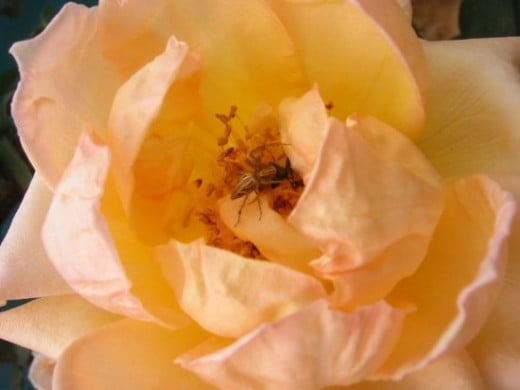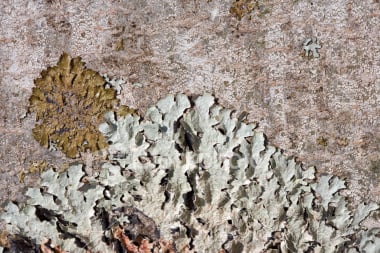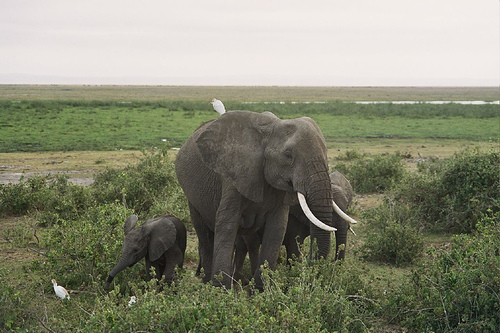The Meaning of Symbiosis
Symbiotic species



Withous symbiosis, the earth we know would be far different
Symbiosis is the relationship of two different species to each other where each provides something the other cannot provide for itself. It is derived from the Greek, Sym for with and Biosis for living. Two unlike species co-exist and one provides benefits for the other and vice versa. Both may be enhanced by the relationship, depending on the type of symbiosis involved.
The common lichen is made up of two species; algae and fungi. An alga is capable of photosynthesis and provides life giving energy in the form of sugars to itself and the host fungi in which it is embedded. The fungi, being tough in the case of lichen, provide protection, nutrients digested from rock and shelter to the algae. There are a host of symbiotic relationships in nature and there are various shades of symbiotic relationships.
Another example of symbiosis is the relationship between the clownfish that dwells among the tentacles of the anemone. The territorial clownfish protects the anemone from other anemones and fish, and in turn the tentacles of the anemone protect the clownfish from its enemies. A special coating on the clownfish protects it from the stinging tentacles of the anemones.
Various African birds have a symbiotic relationship with the rhinocerous. The rhino provides the bird with insect meals in the form of parasites on the rhino. When danger threatens, the bird calls out and flees, putting the rhino on alert. The rhino then chases off the threat and the birds return when all is safe.
Human beings have developed a symbiosis of sorts with the dog and cat. The dog is indispensable, especially to early man, for pack hunting and game tracking. Human beings could take down large prey in great numbers that the dogs could only dream of and the kill is shared between them. Further, humans could cure meat against lean times. As human beings could grow and store food, rats and mice were attracted to the stores. Cats and some prey birds were attracted to the rodents. Man formed a relationship with cats, providing access to rodents and giving cats shelter.
Mutualist symbiosis describes any relationship between individuals of different where both individuals derive a benefit. Generally, it is considered that only lifelong interactions involving close physical and contact can properly be considered symbiotic realtionships. Mutualistic relationships, may be either obligatory for both species, obligatory for one but facilitative for the other, or facilitative for both. Many restrict the definition of symbiosis to close mutualist relationships. A large percentage of have mutualistic in the form of bacteria that help them digest plant matter, which is more difficult to digest than animal prey. Reefs are the result of mutualism between coral organisms and various types of algae that live inside them.
Most land plants and land ecosystems rely on mutualism between the plants which carbon from the air, and mycorrhyzal fungi which help in extracting minerals from the ground.There also exists a strong mutualist relationship between ants and a specific plant that gives the ants honeydew in exchange for the ants protection of the tree from other leaf eating insects.
Another example of mutualist symbiosis is the goby fish, which sometimes lives together with a shrimp. The shrimp digs and cleans up a burrow in the sand in which both the shrimp and the goby fish live. The shrimp is almost completely blind, leaving it vulnerable to predators when exposed outside of the burrow. In case of danger the goby fish touches the shrimp with its tail to warn it and this causes both the shrimp and goby fish quickly retreat into the safety of the burrow.
One of the most spectacular examples of obligatory mutualism is between the internal bacterium and symbiotic tube worm that live at volcanic vents in the depths of the oceans far from any light. The worm has no digestive tract and is solely reliant on their internal symbionts for nutrition. The bacteria oxidize either hydrogen sulfide or methane which the host supplies to them. These worms were discovered in the late 1980s at the hydrothermal vents near the Galapagos Islands and have since been found at hydrothermal vents and cold seeps in all of the world's oceans. It is this particular relationship that told us that complex life is not necessarily reliant on the presence of free oxygen to exist. Also these organisms can live at temperatures that would fry us.
The most common form of symbiosis is parasitic symbiosis. The parasite gains, but usually at the expense of the host. The most common example of this are disease organisms which are widespread and universal to all species. Some inconvenience the host such as in biotrophic symbiosis, Others kill such as in necrotrophic symbiosis. About half of all animals have a parasitic phase in their life cycle. Almost all living animals including human beings are hosts to one or more parasites.
Symbiosis is so prevalent that the hypothesis of co-evolution was observed and developed by Charles Darwin and others into a working theory. Everyone knows how necessary bees are to pollination of flowers to produce fruit and seeds. A big scare emerged in 2007 with bee colony collapse and the subsequent loss of food that created food shortages and riots in 2008. Birds, ants and bats also play a role in pollination and flowers have evolved to attract a particular animal to assist in pollination. Some flowers are specific to a single pollinator and a relationship between plant and animal has evolved together. Some would argue that this particular type of codependent symbiosis could only have been created by God. But we have learned from observation how species can adapt to new circumstances as a result of our intervention and rather quickly. Nature also intervenes in many ways creating challenges for adaptation and this has been going on from the beginning of life.
Symbiosis is so common in one form or another, that it suggests the the Gia hypothesis is in fact a reality of nature. Science has often remarked that the environment of the Earth has maintained a rather narrow constraint for hundreds of millions of years. Direct evidence can be traced back 800,000 years. Despite eight long ice ages, life has managed to flourish throughout the period. Oxygen levels have been steady as well as temperatures within narrow limits. It has been observed; by way of negation, that the Amazon rain forest creates a daily rain weather cycle. It was only by removing much of the forest that the daily rains began to fail. This lead to the idea that the forest was creating and maintaining the weather. Similar phenomena have been observed when forests have been planted or removed elsewhere. This lends support to a mass symbiosis between many species that is at the heart of the Gia hypothesis.
The Gia hypothesis also tells us that whatever happens to one species effects all others and by implication, the health of the whole web of life. A true case of sensitive dependence has emerged where our actions, no matter how seemingly trifling, have a long range major impact on all life including ourselves. A major example of how slight changes can have a huge impact is with coral bleaching. A minor rise in temperature of one degree Celsius was enough to cause the coral to expel their symbiotic algae. The coral cannot live without the algae and visa versa. Algae provides the energy and carbon fixing and the coral capture food and trace nutrients of the algae. This expelling caused bleaching and a die off en masse of huge tracts of coral. The rest of sea life followed in a die off and new species started to move in. This was thought to be a combination of the effects of El-Nino and global warming. As a result, we should be learning a lot more and gaining respect for life and Earth.
References:
Cordes, E.E. (2005), "Modeling the mutualistic interactions between tubeworms and microbial consortia", PLoS Biol 3(3): 1–10, doi:10.1371/journal.pbio.0030077
Danforth, B.N. & Ascher, J. (1997), "Flowers and Insect Evolution", Science 99: 42, doi:10.1126/science.283.5399.143a,
Isaac, Susan (1992), Fungal-plant interactions, London: Chapman & Hall, ISBN 0-412-36470-0
Sagan, Dorion & Margulis, Lynn (1986), Origins of sex: three billion years of genetic recombination, New Haven, Conn: Yale University Press, ISBN 0-300-03340-0 Sagan,
Dorion & Margulis, Lynn (1997), Microcosmos: Four Billion Years of Evolution from Our Microbial Ancestors, Berkeley: University of California Press, ISBN 0-520-21064-6
Toller, W. W.; Rowan, R. & Knowlton, N. (2001), "Repopulation of Zooxanthellae in the Caribbean Corals Montastraea annularis and M. faveolata following Experimental and Disease-Associated Bleaching", The Biological Bulletin 201(3): 360–373, PMID 11751248,









